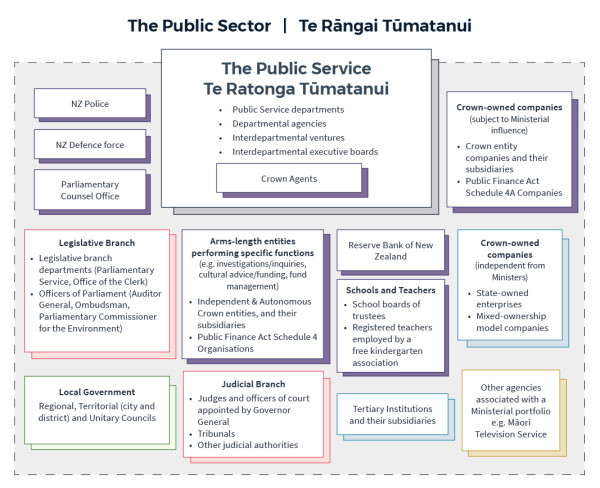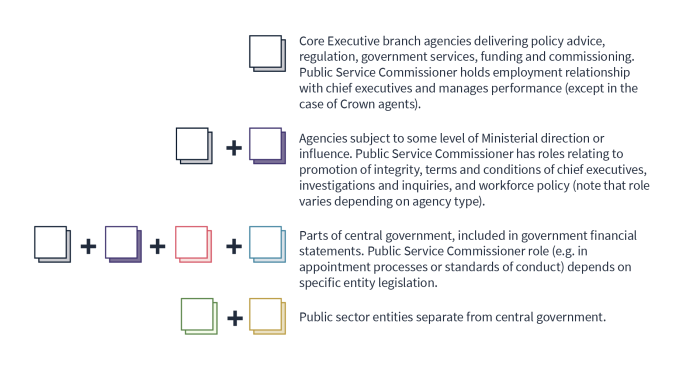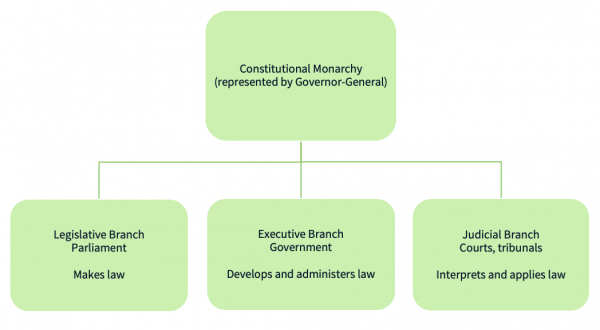Te whakamahere i te rāngai tūmatanui Mapping the public sector
This map shows how the Legislative and Judicial branches of government, and local government, sit alongside the many bodies making up the Executive branch.
All these organisations except local government and ‘other organisations associated with a ministerial portfolio’ form part of the government for the purposes of financial reporting.

Key

New Zealand’s public sector includes the border, business, central agencies, cultural, education, emergency, environment, health, housing, international and trade, justice, national security, populations and communities, social and transport sectors:
Ngā peka kāwanatanga Branches of government
New Zealand’s system of government is known as a Westminster model, because it is modelled on the United Kingdom’s parliamentary system. Under the Westminster model, government is organised in 3 distinct branches. This separation of powers ensures power can’t be concentrated entirely in one place and that no single branch of government can abuse its power or exercise undue power in relation to the others.

The branches are:
- Parliament (the Legislature), which makes the laws
- the Courts (the Judiciary), which interpret the laws
- the Government (the Executive), which administers the laws.
The Governor-General, who is the Sovereign’s representative, is responsible for:
- granting Royal assent to the bills passed by the House of Representatives, thus passing them into law (Legislative branch)
- appointing judges (Judicial branch)
- appointing the prime minister after each election and appointing all other ministers, making regulations proposed by the Executive (‘Orders in Council’), and confirming the appointments of Public Service chief executives (Executive branch).
New Zealand’s central government organisations
Use the glossary to understand terms used on this page.
Glossary — System architecture and design
Branch roles and functions
Each branch of government has specific roles, components, functions, and organisations, offices, officers and instruments.
|
|
3 branches of government |
||
|
|
Legislative branch |
Judicial branch |
Executive branch |
|
Key role |
Makes the law |
Interprets and applies the law |
Develops and administers the law |
|
Components
|
Parliament
|
|
The Government
|
|
Key functions
|
|
|
|
|
Agencies, instruments and officers
|
Parliamentary institutions and offices:
|
|
Organisations
|
Executive government components in detail
-
Prime minister and ministers
The prime minister heads the Executive branch (‘government of the day’) and determines ministerial rankings and portfolio allocations. Ministers act individually and collectively, either in Cabinet or as part of the Executive Council.
-
Executive Council
The Executive Council advises the Governor-General on secondary legislation (Orders in Council) proposed by ministers under provisions of Acts of Parliament. The Executive Council consists of all ministers including those who are not in Cabinet.
-
Cabinet
Cabinet is the central decision-making body of executive government. It is made up of senior ministers and is chaired by the prime minister. It provides a collective forum for ministers to decide significant government issues. Governments in New Zealand traditionally operate using a Cabinet even though legislation does not require this.
-
Cabinet Committees
Cabinet operates through committees that focus on particular areas of the Government’s business, for example, Government expenditure. Responsibility for all policy decisions rests ultimately with Cabinet as a whole. The Cabinet Manual sets out for ministers and officials which matters Cabinet needs to consider and how it should operate.
Cabinet Manual — Department of the Prime Minister and Cabinet
Legislative branch
Parliament (or the Legislature) is responsible for creating legislation. Legislative branch non-Public Service departments and Offices of Parliament are responsible to Parliament and play important roles supporting the operation of the House of Representatives and holding the Executive to account.
-
Non-Public Service departments — Legislative branch
The Parliamentary Service and the Office of the Clerk of the House of Representatives provide services to support the Legislative branch of government (the House of Representatives and all Members of Parliament) rather than the Executive branch. They are accountable to the Speaker of the House, rather than a minister in the Executive.
Parliamentary Service — New Zealand Parliament
Office of the Clerk — New Zealand Parliament
Several other non-Public Service departments are included in the Executive branch.
-
Offices of Parliament
There are 3 Offices of Parliament:
- Office of the Ombudsman
- Office of the Controller and Auditor-General
- Office of the Parliamentary Commissioner for the Environment.
Offices of Parliament — New Zealand Parliament
The offices act as a check on the Executive branch’s use of power and resources. In this role, they should only perform functions the House of Representatives itself might properly undertake — which is why they are Offices of Parliament.
The offices:
- exercise considerable powers (for example powers of entry and investigative functions) in relation to agencies across government
- are constitutionally important planks in democratic government
- are accountable to Parliament for their operations.
Judicial branch
The Judicial branch operates independently of the Executive. The Governor-General appoints its members, and the Remuneration Authority determines their salaries. However, the Public Service carries out all the operations that support the Judiciary: the Ministry of Justice maintains and operates the court infrastructure and services, and the Department of Corrections runs prison and probation services.
How the justice system works — Ministry of Justice
The Public Service
The Public Service is part of the Executive branch. Section 11 of the Public Service Act 2020 states the purpose of the Public Service is to:
- support constitutional and democratic government
- enable both the current and successive governments to develop and implement their policies
- deliver high-quality and efficient public services
- support the Government to pursue the long-term public interest
- facilitate active citizenship
- act in accordance with the law.
To achieve this purpose, section 12 of the Act defines the key principles of politically neutral, free and frank advice, merit-based appointments, open government and stewardship.
Section 11, Public Service Act 2020 — New Zealand Legislation
Section 12, Public Service Act 2020 — New Zealand Legislation
Public Service agencies operate under a close, hierarchical relationship with ministers. While the formal relationship between ministers and the Public Service is governed primarily by the Public Service Act 2020 and the Public Finance Act 1989, it is also governed by convention. Find more information about the relationship between ministers and departments in Chapter 3 of the Cabinet Manual.
Cabinet Manual — Department of the Prime Minister and Cabinet
Public Service agencies
The Public Service Act 2020 defines Public Service agencies as departments, departmental agencies, interdepartmental executive boards and interdepartmental ventures.
Schedule 2, Public Service Act 2020 — New Zealand Legislation
Each department or departmental agency is headed by a chief executive, all of whom are appointed by the Public Service Commissioner (the Commissioner), subject to confirmation by the Governor-General. The Commissioner is their employer in terms of rights, powers and duties. The process for appointing chief executives is detailed in Schedule 7 of the Public Service Act.
The exceptions are:
- the Public Service Commissioner (appointed under statutory power by the Governor-General on the recommendation of the prime minister)
- the Solicitor-General, who holds office under an appointment (under the Crown prerogative rather than statutory power) from the Governor-General.
Schedule 7, Public Service Act 2020 — New Zealand Legislation
Interdepartmental executive boards and interdepartmental ventures bring together groups of Public Service chief executives to work on cross-agency issues.
Supplementary guidance note: departmental agencies
Supplementary guidance note: interdepartmental ventures
Supplementary guidance note: interdepartmental executive boards
Central agencies
These 3 Public Service departments are known as the ‘central agencies’ because they have responsibilities that spread over all portfolios:
Home — Department of Prime Minister and Cabinet
Other organisations in the Executive Branch
-
Non-Public Service departments — Executive branch
New Zealand Defence Force, Parliamentary Counsel Office and New Zealand Police have a different legal and constitutional relationship with ministers than a Public Service department and are not covered by the Public Service Act 2020. Like Public Service departments, they are part of the Executive branch and must remain accountable to Parliament.
-
Statutory Crown entities
Key characteristics of Crown entities include:
- they are established as a body corporate, legally separate from the Crown
- ministers’ powers and relationships with Crown entities are more formal and structured (arms’ length) than is the case for the Public Service, and are conducted through the Board chair. Depending on their categorisation and the type of entity, Crown entities may be subject to ministerial directions to give effect or have regard to government policy
- they operate under the Crown Entities Act 2004 and their own enabling legislation (in the case of Crown entity companies, the Companies Act and their constitution).
Crown agents
Crown agents are the type of Crown entity most like departments in function. Although they are at arms’ length from government, ministers have the power to direct Crown agents to give effect to government policy.
Crown agents are also included in the legal definition of the Public Service for the purposes of shared principles, values, spirit of service and standards of integrity and conduct in Part 1 (subparts 2 and 4) of the Public Service Act 2020. For other matters they are governed by their own establishing legislation and by the Crown Entities Act 2004.
Autonomous and independent Crown entities
Autonomous and independent Crown entities have a more distant relationship with ministers.
- Autonomous Crown entities often have cultural or funding-related purposes and ministers may direct them to have regard to government policy.
- Independent Crown entities are usually established to fulfil investigatory or inquiry roles where independence from ministers is seen as paramount. They can only be directed in relation to government policy if their legislation specifically provides for this.
Other entities with similar provisions
Schedule 4 organisations
The organisations named in Schedule 4 of the Public Finance Act 1989 are legacy organisations such as trusts and Fish and Game councils whose size and function do not justify application of the full Crown entity administrative and accountability requirements.
Schedule 4, Public Finance Act 1989 — New Zealand Legislation
Reserve Bank of New Zealand
The Reserve Bank operates under its own legislation. It acts as the central bank and main prudential regulator and supervisor for New Zealand. It is a body corporate distinct from its members, office holders, employees, and the Crown and continues in existence until dissolved by an Act.
Reserve Bank of New Zealand Act 2021 — New Zealand Legislation
-
Education
Schools and teachers
School boards (of State schools) are a category of Crown entity under the Crown Entities Act, although their relationship with government is largely through the Ministry of Education.
Schedule 3, Crown Entities Act 2004 — New Zealand Legislation
Registered teachers employed by a free kindergarten association are also recognised as part of the ‘education service’. This means the Crown is responsible for their payroll and their employment terms and conditions are negotiated with the Public Service Commissioner.
Tertiary institutions
Institutions are defined in section 10 of the Education and Training Act 2020 as the New Zealand Institute of Skills and Technology (including its subsidiaries), universities and wānanga. Their legislation tries to balance public interest in tertiary education with academic and operational freedom.
Section 10, Education and Training Act 2020 — New Zealand Legislation
Section 266, Education and Training Act 2020 — New Zealand Legislation
Tertiary institutions are Crown entities for the purposes of the Crown Entities Act 2004, although covered by a very limited subset of the Act’s provisions (set out in Schedule 4 of the Act).
Crown Entities Act 2004 — New Zealand Legislation
Schedule 4, Crown Entities Act 2004 — New Zealand Legislation
Tertiary institutions are explicitly excluded from the definition of State services in the Public Service Act 2020. They are therefore not covered by the Act’s provisions regarding integrity and conduct or employment.
-
Crown-owned companies
All Crown-owned companies exist to deliver a public benefit using commercial disciplines.
Crown entity and Schedule 4A companies
Crown entity companies are wholly owned by the Crown (through shareholding ministers) and listed in Schedule 2 of the Crown Entities Act 2004.
Schedule 2, Crown Entities Act 2004 — New Zealand Legislation
Public Finance Act 1989 Schedule 4A companies may include other shareholders if they are majority-owned by the Crown along with other minority shareholders.
Both types of company are covered by provisions in the Crown Entities Act 2004 and Public Service Act 2020 and subject to some ministerial influence.
Schedule 4A, Public Finance Act 1989 — New Zealand Legislation
State-owned enterprises
State-owned enterprises (SOEs) are wholly owned by the Crown and all shares are held by the Minister of Finance and the Minister for State-Owned Enterprises. An SOE’s principal objective is to operate as a successful business by being as profitable and efficient as comparable businesses that are not owned by the Crown. Due to this objective, ministers generally have very limited influence.
SOEs must be good employers and display a sense of social responsibility by having regard to the interests of the community they operate in. SOEs are listed in Schedule 1 of the State-Owned Enterprises Act 1986, and include, for example, New Zealand Post and KiwiRail.
Schedule 1, State-Owned Enterprises Act 1986 — New Zealand Legislation
Mixed ownership model companies
Like SOEs, mixed-ownership model companies must operate as successful businesses. Unlike SOEs, these companies are only majority owned by the Crown and are publicly listed. Mixed ownership model companies are named in Schedule 5 of the Public Finance Act 1989 — Mercury NZ, Meridian Energy and Genesis Energy.
Schedule 5, Public Finance Act 1989 — New Zealand Legislation
Local government
In New Zealand, local government:
- comprises all local authorities, that is, regional councils, territorial authorities (city councils and district councils), and unitary authorities combining both sets of functions
- includes council organisations, council-controlled organisations and council-controlled trading organisations as defined in section 6 of the Local Government Act 2002.
Section 6, Local Government Act 2002 — New Zealand Legislation
Agencies associated with a ministerial portfolio
Some organisations are not included in the Government’s annual financial statements prepared under the Public Finance Act 1989 but are included here because they are associated with a ministerial portfolio.
The association with a ministerial portfolio could arise because:
- the minister appoints some board/committee members
- the minister has delegated authority to set fees for the members of the body in accordance with the Fees Framework approved by Cabinet
- the agency has a role in providing independent advice to the minister
- the agency has some reporting obligations to the minister
- the minister has some other involvement with the agency.
These organisations cover a variety of statutory and non-statutory organisational types:
- committees, for example, New Zealand Vice Chancellors’ Committee
- authorities, for example, Advertising Standards Authority, New Zealand Horticulture Export Authority
- boards, for example, New Zealand Parole Board, Government Superannuation Appeals Board
- commissions, for example, Gambling Commission, Local Government Commission
- trusts, for example, Queen Elizabeth II National Trust, Winston Churchill Memorial Trust
- councils, Armed Forces Canteen Council, Radiation Safety Advisory Council.
Although many of these organisations are not subject to the reporting regime under the Public Finance Act 1989, some, such as the Māori Television Service and the New Zealand Council of Legal Education, are significant bodies and are required by their own legislation to account to Parliament by preparing an annual report for their minister to table in the House of Representatives.
Te whai kia whaikiko te mahi a te rangai tūmatanui Ensuring the public sector operates effectively
Appropriate structures, strong governance and clear accountability help the Public Service and wider public sector organisations to work together to deliver better outcomes for the public.
Changes in what the public expects from government over time sometimes requires setting up new bodies or making major changes to government organisations. This is often called changing the machinery of government.
System design
Appropriate structures, strong governance and clear accountability help the Public Service and wider public sector organisations to work together to deliver better outcomes for the public.